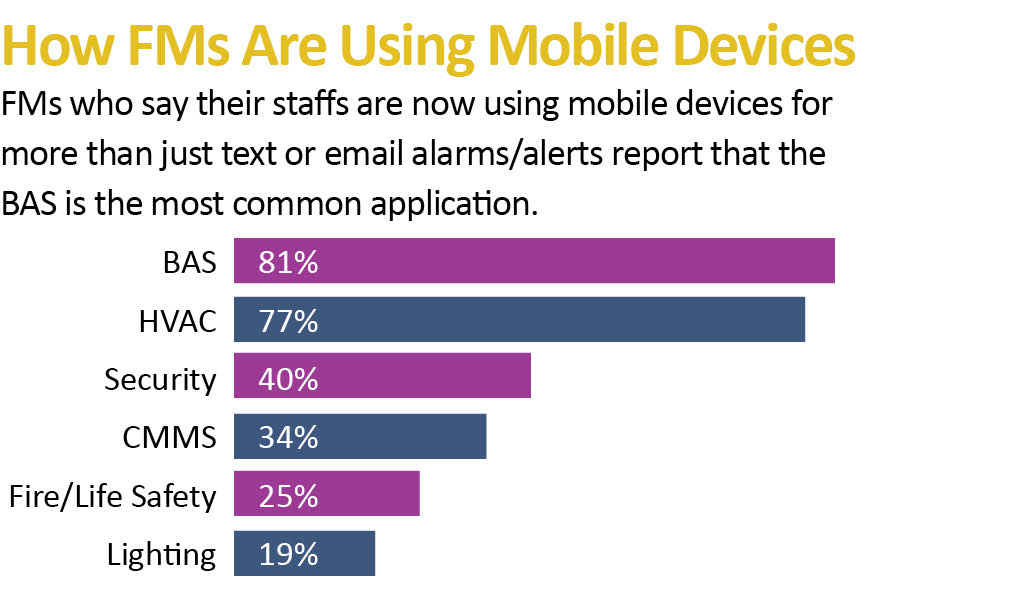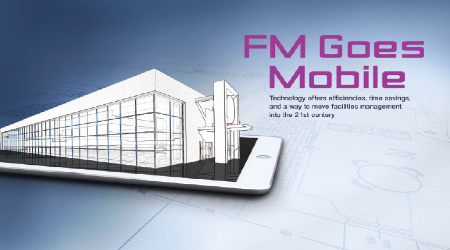Benefits of Mobile for Facility Managers: Time Saved, Faster Response
Part 2 of a 4-part cover story on how facility managers are making use of mobile technology to create efficiencies.
Labor efficiency — or simply time saved — is another key metric and benefit of using mobile technology effectively. Time saved by using CMMS on mobile is one of the most-cited advantages of mobile technology — indeed, 73 percent of respondents to the BOM survey said mobile technology helped improve work-order response time and tracking, and 62 percent said it improved workflow and reduced work order redundancy.
Strazdas is the poster child for using mobile for work orders. He’s spent the last several years implementing a process of creating BIM models for all his buildings, and then, with some cooperation between vendors, tying the BIM models to his CMMS and making it all available on tablets.
“In essence, we bring a library room full of books directly to our technicians’ iPads,” he says. “The travel time is cut significantly.” That’s because the technicians can do their research on their tablets directly in front of a piece of equipment, not have to travel back and forth to get information from a computer, or worse, maintenance manual. “A computer in the shop did OK for awhile,” he says.
“Now the shop computer is in their tool box vis-à-vis their iPads. All the information in the library is scanned, and the iPads include all the applications they need.”
One thing to keep in mind, Strazdas says, is that the more information you make available, the easier you need to make it to find what you’re looking for. “How do you find the needle in the haystack on this little device?” he says. “Make sure the information is easily retrieved.” Strazdas created a standard “home page” on the iPads that includes links to all the technicians’ favorite applications, and a search engine to search BIM information.
Strazdas says that in the first year of measuring reduced time on work orders, labor efficiency improved 15 percent, with a savings of $524,000.
Remelius also has his staff use tablets for his maintenance and work orders, and speed of response is certainly a benefit for him, too. “Cuts out a lot of time,” he says. “The technician is standing there with an iPad and can look at a chiller or pump and tell it to go on or off. You can tap your tablet and watch a damper open and close and see if the temperature changes up- or downstream. Maintenance has become real time.”
Remelius says another advantage of the tablets is that, with 10 buildings spread out over the school district, it’s much easier to keep track of where his technicians are and what they’re doing.
“It’s the idea of accountability,” Remelius says. “If mechanics are lone cowboys driving around in their trucks doing whatever they want to do, you don’t need that. You don’t need someone driving from building to building. Windshield time is expensive.”
While facility staff might at first balk if they feel like Big Brother is watching, Remelius says the way you overcome resistance to this hesitation specifically, but to mobile technology more generally, is simply to prove to staff how it makes their jobs easier.
“It’s actually faster to use the CMMS app on the mobile device than on a laptop,” he says. Show the technicians how it’s simpler, and you can overcome some of the resistance to switching to mobile, he says. “The fact of the matter is that most people have smart phones, and so with the exception of one or two guys, the technology was something they were already using.”
But for those who aren’t familiar, a simple way to overcome resistance is to assure proper training — to demystify the technology.
“You don’t want to create a foreign culture,” says Strazdas. “If you shift quickly to a process that is too foreign, you might as well put that device on a shelf.” The goal, he says, is to mimic as much as possible the previous paper-based processes. “So what they see on the screen looks like what they’ve been using. It makes it more comfortable.”
Strazdas says one of the keys to implementation for him was finding a group of “peer champions” among his technicians. “We have a bunch of people who love technology,” he says. “We selected a few people geeked up at the technology, had them sit at lunch tables and show their buddies. It was more peer training and peer pressure than top down.” Again, he says, the important thing is showing how that helps them, not causes them more work.

Mobile and Job Security
If all else fails, the silver bullet is showing them how a failure to learn mobile technology makes them obsolete. Some may worry that implementation of fancy mobile technology in their organizations will wind up putting them out of a job. After assuring them the facility department won’t be run by robots anytime soon, you can show them how learning and using the latest and greatest is actually saving their jobs, not replacing them. “If you don’t figure this out, you’re going to work your way out of a job,” says Strazdas. “It takes initiative, it takes guts.”
Tetrault agrees: “As FMs, we need to embrace this to improve our overall operations.” He says the biggest source of resistance to moving to mobile in his organization has been the fact that the technicians are responsible for the cost of an iPad if they break it. But he says they’ve only broken one in five years, so it’s a resistance that quickly melted away.
For Remelius, mobile technology is simply a non-negotiable core competency of facility management now. “Our guys are figuring out that it’s part of the job, just like wrenches and tool belts.”
And that’s especially true as buildings become increasingly complex, smart, and technology-based. Managing this new era of buildings with the new era of mobile technology is only natural.
“Always look at what the leading edge is,” says Morgan. “As we move to an IT, metrics-based world, you need to take a holistic technology approach.” What he means is using mobile technology to create synergies, making a mobile device a one-stop shop to control the BAS, HVAC, lighting, security, and everything else.“Anything that can be integrated into one platform, we should be all about that,” he says.
Strazdas agrees: “Buildings are more intelligent, and buildings are functioning and communicating as a system,” he says. “So you have to understand and appreciate how systems are interconnected. It’s another reason for the ability to have access to more information.”
And that’s the whole rub: Easier access to information means easier and more efficient action on that information. And those are benefits any facility manager would be silly to miss.
“We have to find ways to do more with less,” says Strazdas. “This is a clear path for doing that.”
Email comments and questions to greg.zimmerman@tradepress.com.
Related Topics:
















